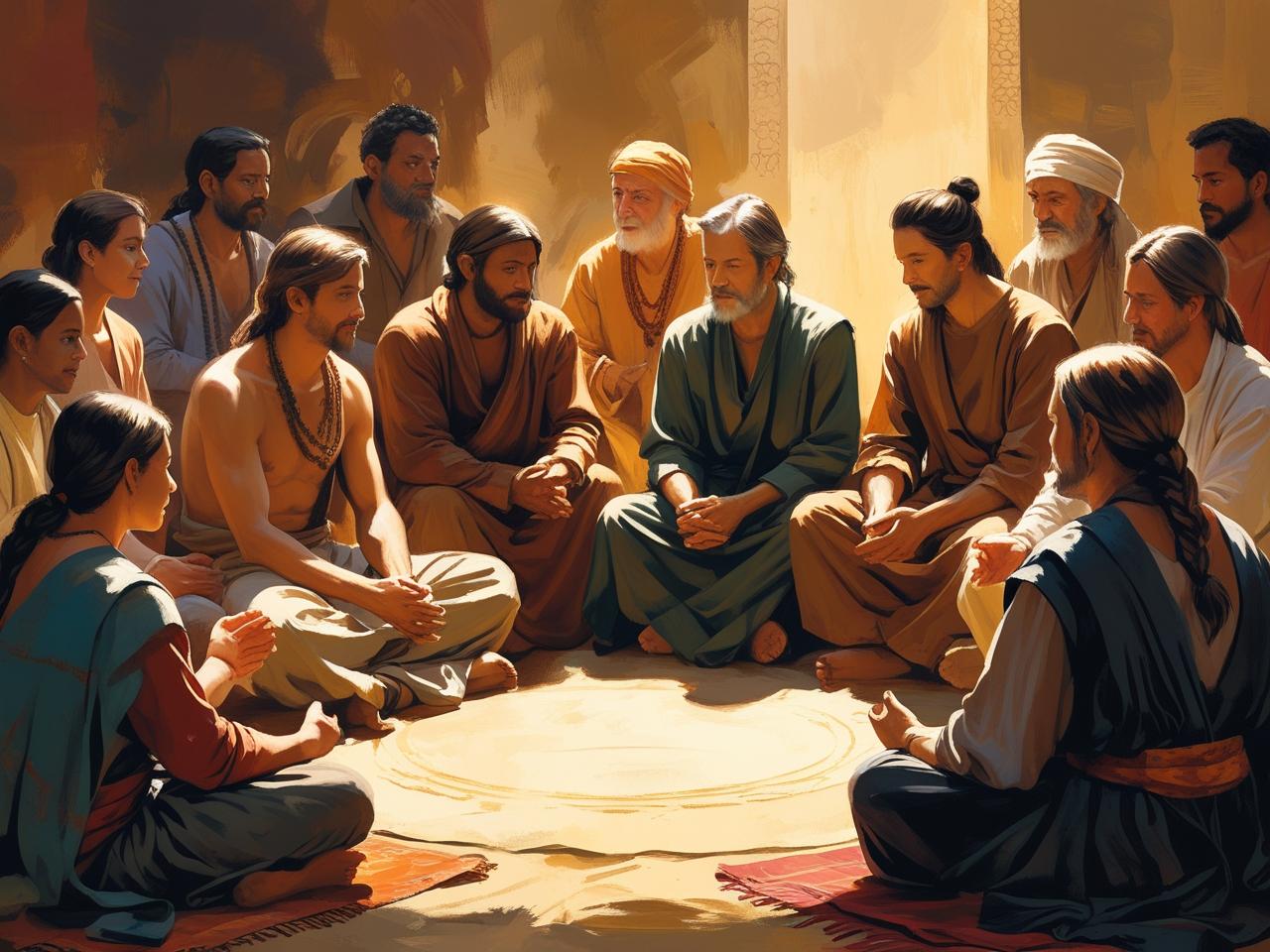From the ancient times to modern days, humanity has constantly looked for guidance, meaning, and truth. We often seek comfort in something bigger than ourselves – we call it God, the Universe, the Source, the Creator, and so on. Great souls like Gautam Buddha, Mahadev (Shiva), Krishna, Ram, Jesus, Prophet Muhammad (PBUH), Guru Nanak, Sai Baba, and others came to this world, not to be worshipped as gods, but to show us how to live meaningful and conscious lives.
However, over time, we humans, in our eagerness to explain the unexplainable, started turning these great teachers into idols, into objects of worship. We forgot their core message and focused on creating rituals, rules, and religions around them. In our attempt to “know everything,” we complicated the simple truths they shared. In this article, let’s deeply explore how this happened, what their real messages were, and how we can return to the essence of their teachings.
The Problem: Overcomplicating the Simple
In our hearts, we all seek peace, happiness, love, and understanding. These enlightened beings came to help us find exactly that. But somewhere along the line, their teachings were turned into systems, and their systems became religions, and religions became politics.
Today, instead of following what Buddha said, people worship his statue. Instead of embodying the love and forgiveness that Jesus taught, many focus on the cross and the church. Instead of living with the awareness of Krishna’s wisdom, people are busy performing rituals without knowing why. Instead of connecting to the energy of Mahadev, we argue about who Shiva really was.
We turned their living, breathing wisdom into lifeless doctrine.
Gautam Buddha: A Seeker of Truth, Not a God
Gautam Buddha never claimed to be God. He never said, “Worship me.” In fact, he encouraged people to question everything, even his own teachings. His message was simple:
- All life is suffering (Dukkha).
- Suffering comes from attachment and desire.
- You can end suffering by letting go.
- There is a path to achieve that: The Noble Eightfold Path.
What he truly taught was mindfulness, self-awareness, compassion, and detachment from material illusions. Buddha believed in Dharma – the natural order of life. He said nature is the greatest teacher. Trees grow, rivers flow, birds sing, and they don’t fight about beliefs.
Yet today, many Buddhists build grand statues, chant without understanding, and treat Buddha like a deity. That’s not what he wanted.
Shiva – The Silent Yogi, Not Just a Myth
Shiva, or Mahadev, is often called the Adiyogi – the first yogi. His wisdom was beyond time. He meditated for thousands of years, deeply connected to the universe. He never said, “I am God, worship me.” His image represents inner stillness, destruction of ego, and balance between creation and destruction.
Shiva taught:
- Be in balance with yourself and nature.
- Let go of your ego.
- Practice awareness (yoga).
Today, many celebrate Shiva Ratri with alcohol and loud music – forgetting that Shiva was a silent, meditative being. His real message was about inner transformation, not outer celebration.
Krishna: The Divine Friend, Not a Warrior God
Krishna’s life is filled with color, love, music, wisdom, and strategy. But he was not just a “god” with a flute. His teachings in the Bhagavad Gita are profound spiritual guidance.
Krishna said:
- Do your duty without attachment.
- Don’t run after results.
- Surrender to the divine inside you.
He taught how to live in the world, but not be of the world. He wanted us to find our truth, understand our dharma, and stay in action without ego.
But now, people celebrate Janmashtami with massive events, noise, and competition – forgetting Krishna’s quiet, wise presence and his divine joy.
Jesus Christ: Love, Forgiveness, Simplicity
Jesus, like others, never said, “Make a religion in my name.” He taught love. He showed compassion to the poor, forgiveness to sinners, and connection with God through simplicity.
He said:
- Love your neighbor as yourself.
- Forgive seventy times seven.
- The kingdom of God is within you.
Yet today, we see divisions in his name. So many churches, denominations, and conflicts arose from someone who simply wanted us to love each other. The cross became more important than the message.
Prophet Muhammad (PBUH): Peace and Brotherhood
Islam, in its root meaning, means peace and submission. Prophet Muhammad taught humility, honesty, charity, and respect.
He said:
- Serve the poor.
- Speak the truth.
- Treat everyone equally.
But over time, political conflicts, interpretations, and rituals created walls instead of bridges. His beautiful message of unity got buried in noise.
Guru Nanak: Oneness and Equality
Guru Nanak, the founder of Sikhism, rejected rituals and caste. He said, “There is no Hindu, there is no Muslim.”
His teachings focused on:
- One God.
- Honest work.
- Sharing with others.
- Remembering God always.
Today, the essence of his message often gets overshadowed by rituals and identity politics. But Nanak was all about simplicity, equality, and devotion.
Sai Baba: Sabka Malik Ek (One God for All)
Sai Baba of Shirdi lived a life of simplicity, compassion, and unity. He didn’t care about religion. He said, “Allah Malik” and lived in a mosque, yet used Hindu symbols too. His message was universal:
- Help others.
- Love all.
- God is one.
He healed people not by magic but by showing them the power of faith and inner strength.
Yet today, his image is on calendars and temples, and the focus has shifted from his message to his miracles.
What Went Wrong?
So how did we get here?
- We Forgot the Essence: We focused on symbols more than the substance.
- We Built Religions: Instead of following universal truths, we created separated identities.
- We Stopped Questioning: Great teachers encouraged questions, but religions discouraged them.
- We Looked Outside: All of them said to go within, but we started looking outward for salvation.
What Can We Do Now?
It’s not too late to come back to the real teachings. Here are a few simple steps:
- Read Their Words, Not Just Follow Rituals: Study the Gita, the Dhammapada, the Bible, the Quran, the Guru Granth Sahib. Understand what they really said.
- Live Like Them: Be kind, be aware, love more, judge less.
- Meditate and Reflect: All of them spent time in silence. You should too.
- Respect Nature: Nature is the biggest temple. Protect it.
- Stop Arguing About Religion: We all want peace, truth, and love. Let’s unite on that.
- Teach the Next Generation: Share the real teachings, not just cultural practices.
Conclusion: The Divine Is Within Us All
All these great beings were trying to tell us one thing:
“You have everything you need inside you. Wake up. Become aware. Realize your truth.”
Krishna, Buddha, Jesus, Nanak, Muhammad, Sai Baba, Shiva all showed us a path. Not to worship them, but to become like them. To walk the path, not build temples around it.
Let us stop trying to be the “most religious” and start being truly spiritual. Let us not fight about who is God, but remember what Godliness feels like: love, peace, truth, and kindness.
In the end, the biggest dharma is to live in harmony with yourself, with others, and with the universe.
Let’s return to that simple truth.

